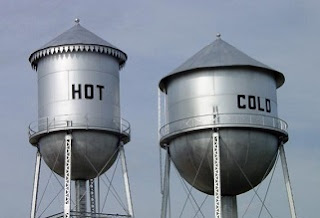It's been a while since we've seen the work of some of our favorite dummies. You know who we mean, the ones who claim higher education degrees but can't seem to get the handle of grammar school problems. Even worse are the ones who teach in grammar school, but don't get it... Today, we'll pay a visit to the scintillating prose and razor-sharp descriptions of one such freelancer, a "teacher with a masters degree in education" that we already know is scientifically and mathematically illiterate: she's Demand Media's Charlotte Johnson, found this time wreaking her peculiar brand of havoc on "How to Calculate Gallons and Tank Volume" for DMS (ever noticed that you can't spell "dumbass" without "DMS"?), which has now been moved to Sciencing.com by Leaf Group.
Right up front we'll tell you that a careful reading of Johnson's words won't turn up any mathematical errors (unlike some of her other posts). No, she provides correct formulas for the only two shapes she mentions; rectangular solid and cylinder. Where Charlotte's problems arise is in her inability to think through the problem itself. Take, for instance, her instructions for the rectangular tank:
Lots of eHow's self-appointed experts tell you to measure the radius, but few if any of them ever tell you how to find the center of a circle, the dumbasses. We wish more of them would explain how to derive radius (r) from circumference (C): r = C / 2π). But no, it's just "Measure the radius"... More to the point, Johnson says nothing about any other tank shapes, nor does she address a general formula: just specific answers for two common shapes (a problem Charlotte's had before). Just how would one calculate the volume of the water towers shown above? Oops...
MM - GEOMETRY
Right up front we'll tell you that a careful reading of Johnson's words won't turn up any mathematical errors (unlike some of her other posts). No, she provides correct formulas for the only two shapes she mentions; rectangular solid and cylinder. Where Charlotte's problems arise is in her inability to think through the problem itself. Take, for instance, her instructions for the rectangular tank:
- Use a tape measure to measure the length of the tank. Measure the width and depth of the tank as well.
- Multiply the length, width and depth measurements in order to find the cubic volume.
- Divide the cubic volume in inches by 231, as a gallon is equal to 231 cubic inches.
Fair enough... except the instructions simply say to "measure": what if the student measures in feet, meters, centimeters, yards, furlongs...? Assuming the tank is as big as the one in her article photo, we'd expect tank measurements in feet; with a conversion factor of 7.48 gallons per ft³. But no, Charlotte's only thinking in terms of teensy tanks. And then there are her instructions for cylindrical tanks:"Measure the radius of the tank. The radius is the distance from the center of the tank to its outer edge. Another way to find the radius is to divide the diameter (width) by two." |
copyright © 2016-2022 scmrak
MM - GEOMETRY


No comments:
Post a Comment